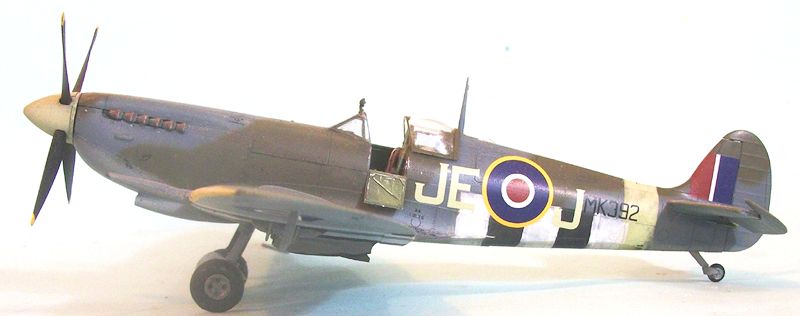
Eduard 1/48 Sptifire IXe
| KIT #: | |
| PRICE: | $ |
| DECALS: | One option |
| REVIEWER: | Tom Cleaver |
| NOTES: | Weekend Edition |

| HISTORY |
The Spitfire IXe was a development of the standard Spitfire IX
that inverted the position of the 20mm cannons and replaced the outboard
.30 caliber machine guns with .50 caliber weapons in the wing position
formerly occupied by the cannons.
Interestingly enough, while the IXe wing entered production in
the Spring of 1944, many Spitfires thought to be examples of this
sub-type are actually earlier Spitfires, with a “field modification” to
change the gun position, without the inner .50 caliber weapon, which was
done due to the fact that with Spitfires being equipped with bomb racks
for the fighter-bomber role in the invasion of France, having a 250-lb
bomb and a 20mm cannon in the same wing location put too much strain on
the wing structure.
Such an airplane was MK392, the Spitfire flown by Wing Commander
Johnny Johnson when he returned to combat operations in March 1944 to
assume command of a second Canadian Spitfire wing, 144 Wing in 83 Group
of the 2nd Tactical Air Force which became 144 RCAF (Fighter) Wing, a
fighter/bomber unit comprised of 441, 442 and 443 Squadrons.
Following the 144 Normandy Invasion, 144 Wing became the first
Allied unit to be based in Europe, and during the intense aerial battles
over Normandy that summer, the wing be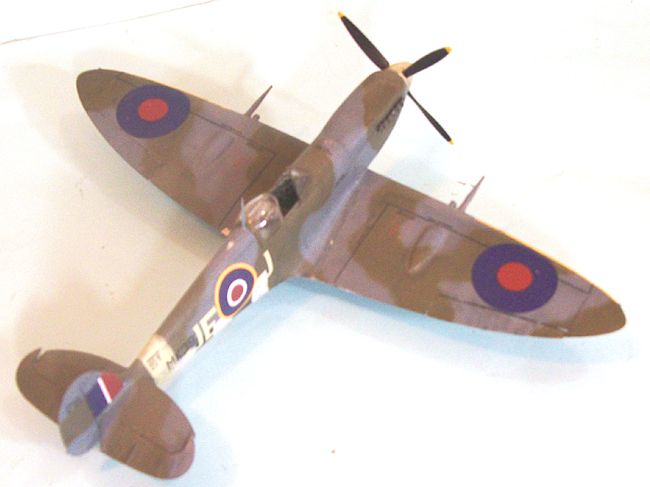 came
the top-scoring RCAF fighter wing of the war.
W/C Johnson scored his 22nd-34th victories while
leading the wing, with his final victory scored on September 27, 1944
over Nijmegen in support of Operation Market Garden.
came
the top-scoring RCAF fighter wing of the war.
W/C Johnson scored his 22nd-34th victories while
leading the wing, with his final victory scored on September 27, 1944
over Nijmegen in support of Operation Market Garden.
Johnson himself thought that the achievement of Sailor Malan in
scoring 32 victories in 1940-41 was superior to his own.
Writing in his autobiography “Wing Leader,” he
said:
Malan had fought with great distinction when the odds
were against him. He matched his handful of Spitfires against greatly
superior numbers of Luftwaffe fighters and bombers. He had been forced
to fight a defensive battle over southern England and often at a
tactical disadvantage, when the top‑cover Messerschmitts were high in
the sun. I had always fought on the offensive, and, after 1941, I had
either a squadron, a wing or sometimes two wings behind me.”
Johnson was credited with 34 individual victories over enemy
aircraft, as well as seven shared victories, three shared probables, 10
damaged, three shared damaged and one destroyed on the ground.
Between 1940-45, he flew 700 operational sorties
and engaged enemy aircraft on 57 occasions. His list of victories
included 14 Bf-109s and 20 Fw-190s destroyed, making him the most
successful RAF ace against the Fw 190, with his total score making him
the highest-scoring Western Allied ace against the Luftwaffe.
MK392, the Spitfire Johnson flew with 144 Wing has now been identified as being originally produced as a Spitfire IXc. In June 1944, Johnson had an MU modify the airplane by changing the gun positions, which was not difficult since MK392 used the large teardrop-shaped “universal gun cover.” All the Spitfires in 144 Wing, which did include some early IXe airplanes that were not equipped with the .50 caliber machine guns (which only made their appearance in the fall of 1944 due to production delays of the weapons), removed the outer .30 caliber weapons to save weight since the rifle-caliber weapons were not considered particularly effective either in strafing or air combat.
| THE KIT |
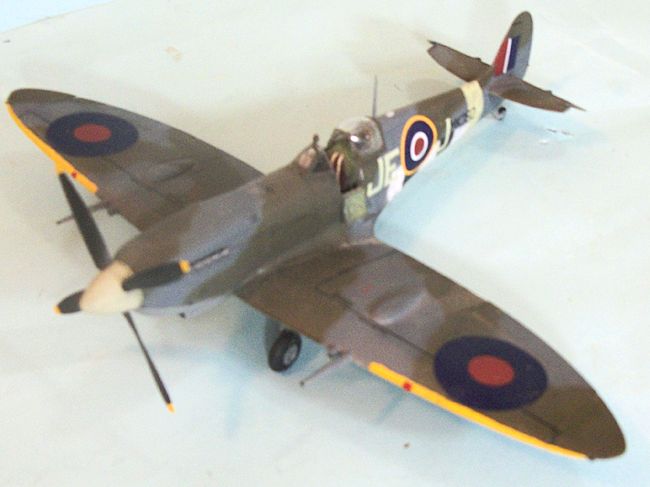 Eduard has determined to make each of their kits of the various
marks of Spitfire IX separate by molding the wings such that there can be no
“mix and match” of gun covers and weapons, as is possible with the Hasegawa
and ICM Spitfire Ixs.
Eduard has determined to make each of their kits of the various
marks of Spitfire IX separate by molding the wings such that there can be no
“mix and match” of gun covers and weapons, as is possible with the Hasegawa
and ICM Spitfire Ixs.
The IXe has come in both a Profipack kit with the usual photo-etch
details and decals for several aircraft, and the less-expensive Weekend
Edition that omits the photo-etch and provides only one set of decals, which
do not include the extensive stenciling found on the Spitfire.
Most modelers of Spitfires have access to
aftermarket decal sheets that provide other markings options and also
contain the necessary stencils, so this lack is not a problem and the
savings on the price allow one to have more than one model in the
collection.
| CONSTRUCTION |
I had determined that I was going to do Johnson’s MK392 after
looking at some photos of how ragged the D-Day stripes were on this plane,
which would allow me to experiment with doing “bad” D-Day stripes, which
most modelers avoid like the plague since they fear uninformed judges at the
International PMS society model contests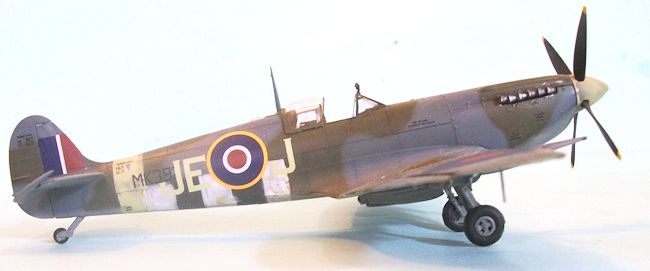 will “ding” them for not “doing them right.”
Since I don’t waste my time on contests, this isn’t
a problem.
will “ding” them for not “doing them right.”
Since I don’t waste my time on contests, this isn’t
a problem.
Of course, once I got the bit in my teeth to do this, using the
decals from “Spitfire: Aces of the Empire,” I did a little reading and
discovered that MK392 was not a standard IXe.
I suppose I could have found an actual IXe with the
markings option I wanted to do, but now I Was Committed.
Fortunately, I happened to have the large “universal
gun cover” in resin from a Spitfire Vc conversion set.
I cut off the narrow-chord gun cover and replaced it
with the resin cover, then proceeded to build the kit as I had all the other
Eduard Spitfires I have done, with the exception of using the instrument
panel decal in place of the non-existent photo-etch and lead foil from a
wine bottle to create seat belts in replacement of the non-existent
photo-etch.
| COLORS & MARKINGS |
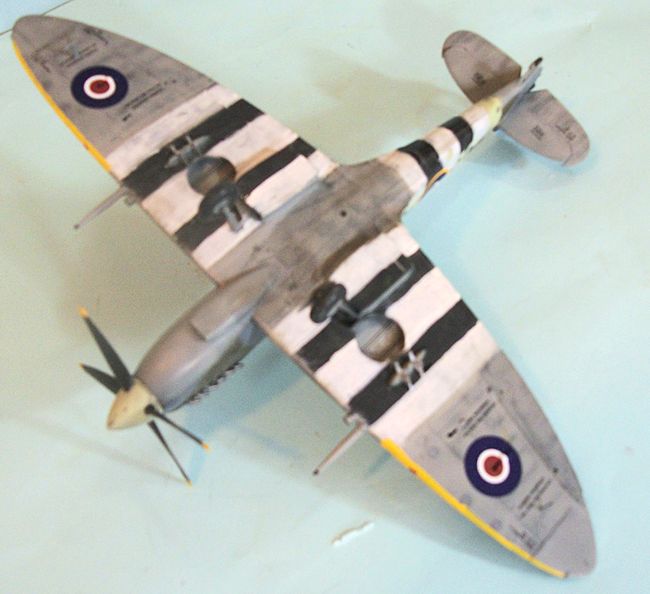 After pre-shading the model with flat black along the panel lines, I
then airbrushed a thin coat of Flat White, which allowed the undersurface
colors through as though it was worn paint.
I then hand-painted the borders of the black
stripes, making certain that no two stripes were the same width, per photos
of MK392, then airbrushed the black stripes.
I then hand painted the outer borders of the stripes
with Sea Grey Medium to get the uneven look.
Past that, the rest of the painting was creating a
standard A-scheme pattern, freehanded with my airbrush (after 30 years of
practice airbrushing Spitfires, I have that pattern down right).
After pre-shading the model with flat black along the panel lines, I
then airbrushed a thin coat of Flat White, which allowed the undersurface
colors through as though it was worn paint.
I then hand-painted the borders of the black
stripes, making certain that no two stripes were the same width, per photos
of MK392, then airbrushed the black stripes.
I then hand painted the outer borders of the stripes
with Sea Grey Medium to get the uneven look.
Past that, the rest of the painting was creating a
standard A-scheme pattern, freehanded with my airbrush (after 30 years of
practice airbrushing Spitfires, I have that pattern down right).
I stained the model with exhaust and oil stains, “dinged” areas that would have been worn, then attached the prop and landing gear and the bomb racks, then the open cockpit flap and the canopy in the open position.
| CONCLUSIONS |
If I was doing
this model over again, knowing what I know now, I would use the Spitfire IXc
“Early Production” kit, which has the universal gun covers.
Other than that, I am quite happy with my “crapped up”
Spitfire.
The Eduard Spitfire IX series are without a doubt the best 1/48
Spitfire Ixs and well worth their price, though the Weekend Edition creates a
nice bargain for those “boffins” who have the necessary items for markings and
such.
Thanks to HobbyLink
Japan for the review kit.
Thanks to Victory
Productions Decals for the Spitfire sheet, the best one available (even if I did
have a hand in creating it).
O
ctober 2014If you would like your product reviewed fairly and fairly quickly, please contact the editor or see other details in the Note to Contributors.